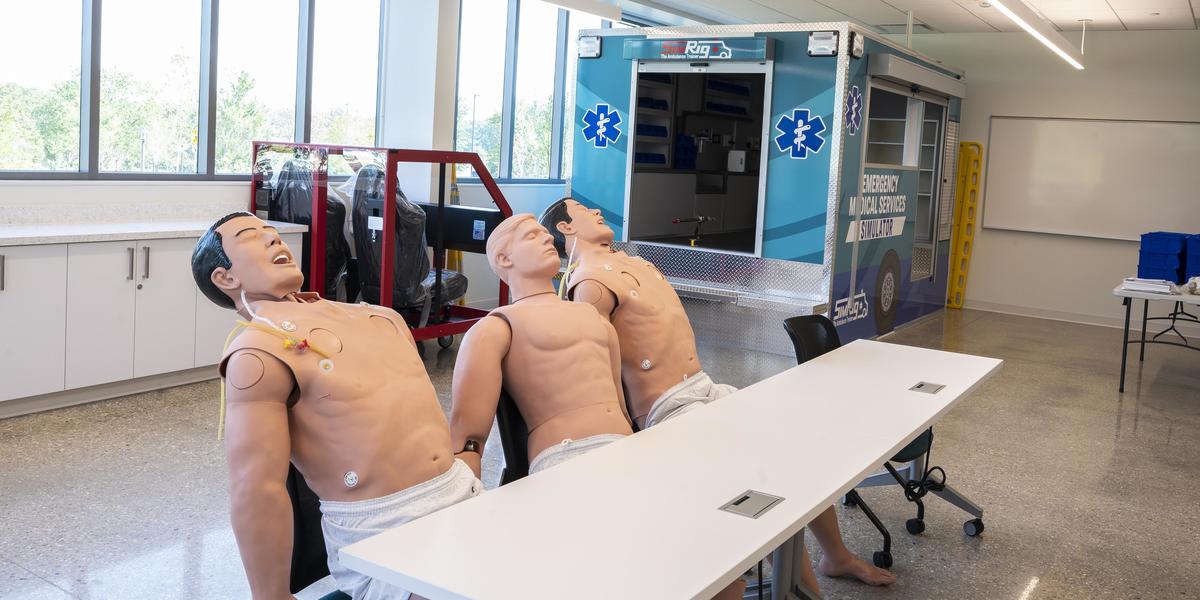
Simulation, Learning and the Future Come Together
The three-story, 175,000-square-foot Health and Life Sciences Building at AACC can evoke a lot of feelings: excitement, awe, and for some, a little bit of dread.
“I have the same scared feeling of going to the dentist when I go through the (dental hygienist) lab. You really feel like you’re there,” said Director of Laboratory and Simulation Education Justin Gyurik while recalling his first stroll through the building’s dental lab.
It’s not just the dental students who will get to learn in a realistic space. Starting this fall, Gyurik will oversee simulation labs for future physical therapist assistants, radiologist technologists, massage therapists and more, allowing students to react to realistic scenarios as part of their hands-on education.
The building’s simulation suite features six areas currently set up to resemble hospital rooms and four areas set up as medical exam rooms. Paper on the bed crinkles, heart monitors beep and “patients” respond. Twenty-seven simulation manikins, with more on the way, are connected to a system that involves a control panel and cameras that record not only the manikins’ status, but also the students’. After working through scenarios, students and faculty move to debriefing rooms where they critique their work instantly. “Faculty can review interactions with students. Everything that they’re doing gets tracked,” Gyurik said.
Simulations are important, says Scott Olden, assistant dean of the nursing program, one of the programs that will use the suite.
“There’s a lot of literature and research that talks about the value of simulation in health care,” he said. “We can simulate anything and that allows students to apply concepts and critically think. When they do go into the field, they’ll have these skills already.”
He said it’s also important to have simulations as realistic as possible, which is why the latest shipments of manikins don’t all look quite alike.
“We’re very intentional about diversity, equity and inclusion. That not only goes in terms of faculty and students, but also manikins,” he said, noting that often a patient population at facilities in the area can be more than 50% people of color. “When a person is not breathing well, one assessment is skin. For a lighter person you’ll see the paleness or blueness, a darker person you need to look at mucus membranes. ... We need to be training our students accordingly as practitioners.”
Along with the new health sciences spaces, Biology students have the run of seven new labs, an Environmental Center, a new, cutting-edge greenhouse, and spaces for the land and sea creatures that live on campus. Additionally, there are two Anatomage tables serving as digital touch-screen cadaver tables.
This is where anatomy and physiology students will learn on the most technologically advanced 3D anatomy visualization system available.
Kirsten Casey, assistant dean of biology, said she’s looking forward to the collaboration in the building between the biology and health students. The programs have been on opposite sides of campus. Now “it will make informal/ spontaneous collaboration far easier,” Casey said. She also foresees health science students easily making a connection between the prerequisites, for example Chemistry 101, and their eventual program.
Dean of the School of Health Sciences Elizabeth Appel also anticipates the ways programs can work together. “Students can see and understand how EMT or paramedics interact with nurses and vice versa. This helps build expectations,” she said. “For example, if there was an emergency at a radiology facility, how would emergency services respond? EMS learn what kind of apparatus they are dealing with in these facilities and what kind of treatment, if any, could be in place. It also helps the radiology students learn what information will expeditiously improve patient outcomes.” This could be applied to every program.
“We’re looking forward to the many interdisciplinary collaborations that will occur, along with all the real world simulations,” she said. And a favorite part of the building? Too hard to choose. “All of it! We can’t wait to move in and get started.”
Classes start Aug. 28 and the new era of simulations begins Sept. 6 with a labor-and-delivery simulation and manikin for the paramedic program, which now boasts a working ambulance located outside the building and a simulated ambulance space in the Emergency Medical Sciences Laboratory.
Medical complications may arise, but our students will be ready.
*Did you know? A manikin is a full-body patient simulator, while a mannequin is more closely aligned to use in fashion.